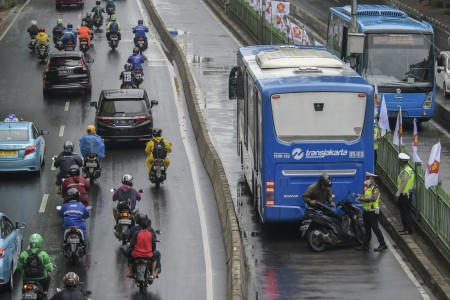Popular Reads
Top Results
Can't find what you're looking for?
View all search resultsPopular Reads
Top Results
Can't find what you're looking for?
View all search resultsEVs and 'compact’ city combo could reach emissions targets: Study
From Paris to Jakarta, cities around the world are pushing public transportation and electric vehicle (EV) adoption to cut down transportation sector emissions.
Change text size
Gift Premium Articles
to Anyone
G
etting more people into electric vehicles (EVs) needs to happen alongside a shift to more "compact" cities where fewer car journeys are needed if governments want to stave off the most dire effects of global warming, researchers said on Thursday.
Curbing urban transport emissions is a narrow but critical piece in the broader fight against climate change, as cities from Paris to Jakarta re-orient their streets to promote public transit use and bicycle and walking paths.
“If politicians think electrification is going to save the day... and everybody’s going to go out and buy an electric vehicle, it’s just not going to work,” said Heather Thompson, chief executive of the Institute for Transportation and Development Policy (ITDP).
The research looked at four scenarios for transport: “business as usual,” massive electrification of public and private vehicles by 2050, a major shift in cities to non-car transport, and a "high EV + shift" combination.
The "EV + shift" scenario was the only one whose estimated 2020-2050 emissions were in line with targets of the 2015 Paris Agreement on climate change, which aims to limit global temperature rise to "well under" 2 degrees Celsius.
The key is minimizing the overall number of vehicles on the road and electrifying the rest, said Thompson, whose nonprofit group developed and released the research in concert with the University of California, Davis, in the United States (US).
Rising emissions
Urban passenger transport represents about 10 percent of the world's climate-changing emissions - but those emissions have been increasing steadily as private vehicles become easier to acquire in emerging economies, the study found.
Researchers acknowledged that putting into place a large-scale "EV + shift" combination would require a "vast global effort," likening it to the construction of the US interstate highway system in the 1950s.
But the study cataloged examples of cities promoting effective land use and public transportation options that others could emulate.
Mexico City, for instance, features both a viable public bikeshare system and policies that disincentivize or reduce parking availability.
In the US, Portland has pushed zoning laws encouraging high-density development, which makes walking to services easier, and Seattle has worked to ensure residents have close access to high-frequency bus routes.
The study pointed out that Paris decreased car travel by almost 50 percent in 30 years by promoting other options, while Jakarta in 2004 opened a mass transit system that drew nearly a million daily riders pre-pandemic.
“We have the solutions. We have the technology. We know which ones are more cost-effective. It’s really about political will,” Thompson told the Thomson Reuters Foundation.
More immediate, tangible steps to promote clean transport - like creating protected bike lanes and sidewalks and boosting rapid transit - would serve people where they already live, she noted.
“These are things that cities can do. It’s not about people moving - it’s about bringing those better transportation options to people wherever they live,” she said.
Roadblocks
Still, even gradual changes to city design and zoning laws can generate massive political blowback - as with hastily installed road barriers designed to make space for walking and cycling in London during an early pandemic lockdown.
A combination of inertia and entrenchment of old designs and thinking are major obstacles, said Brendan Shane, climate director at The Trust for Public Land, a nonprofit group.
“The idea that the road is the principal design feature for a new area… (and that) the car comes first and the people come second still tends to be dominant,” he said.
In the US and elsewhere, competing interests of developers, residents, and local businesses can make it nearly impossible to satisfy everyone.
Jennifer Roberts, the former mayor of Charlotte, North Carolina, recalled a recent conversation with small business owners in a “densifying” neighborhood.
“It was so interesting because half the business owners were like 'We don’t have enough parking' and 'Our customers can't get there,’” she said.
“And the other (half) were like, 'We need less parking – our customers walk and bike to where we are. We want more space for our restaurant – less space for the cars.'”
By 2050, a shift to more compact cities could cut direct public and private costs of urban passenger transport by US$5 trillion per year compared to the “business as usual” and high-electrification-only options, the ITDP report found.
Ballot initiatives in the United States suggest people are capable of embracing such fundamental changes if they see tangible benefits, said Linda Hwang, director of strategy and innovation at The Trust for Public Land.
“We see time and time again people making the choice to tax (themselves) if it means they’re going to get more parks, more trails, more public lands,” she said.
"Nobody likes the word tax and nobody likes a carbon tax, but if you call it a park then they (say), 'Yeah, I’ll pay for that.'"











